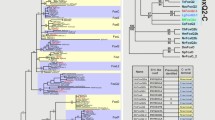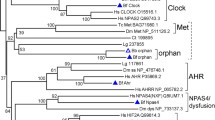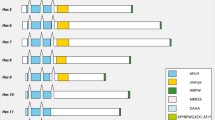Abstract
The olig genes form a small subfamily of basic helix-loop-helix transcription factors. They were discovered in 2000 as genes required for oligodendrocyte lineage specification. Since then, olig genes have been identified in various vertebrate species and corresponding sequences accumulated within genomic databases. Until now, three groups of olig genes have been characterized. Our phylogenetic analysis demonstrates the existence of a fourth group, which we named olig4. Genes of the four olig groups are present in actinopterygians and amphibians, whereas mammals only possess olig1, 2, and 3. We also found one olig gene in hemichordates, urochordates, and cephalochordates. Our expression study during Xenopus tropicalis embryogenesis shows that the four olig genes have very distinct expression patterns. Olig1 is very faintly expressed before the tadpole stage, whereas olig2, 3, and 4 are expressed from the gastrula stage onward. The olig3 expression during neurulation suggests a role in early anteroposterior patterning of the brain. All these results indicate that olig genes are involved in several developmental processes during early development.







Similar content being viewed by others
References
Amiel J, Trochet D, Clement-Ziza M, Munnich A, Lyonnet S (2004) Polyalanine expansions in human. Hum Mol Genet 13(2):R235–R243
Bassez T, Paris J, Omilli F, Dorel C, Osborne HB (1990) Post-transcriptional regulation of ornithine decarboxylase in Xenopus laevis oocytes. Development 110:955–962
Eddy SR (1998) Profile hidden Markov models. Bioinformatics 14:755–763
Edgar RC (2004) MUSCLE: multiple sequence alignment with high accuracy and high throughput. Nucleic Acids Res 32:1792–1797
Filippi A, Tiso N, Deflorian G, Zecchin E, Bortolussi M, Argenton F (2005) The basic helix-loop-helix olig3 establishes the neural plate boundary of the trunk and is necessary for development of the dorsal spinal cord. Proc Natl Acad Sci U S A 102:4377–4382
Gerber HP, Seipel K, Georgiev O, Hofferer M, Hug M, Rusconi S, Schaffner W (1994) Transcriptional activation modulated by homopolymeric glutamine and proline stretches. Science 263:808–811
Gould RM, Morrison HG, Gilland E, Campbell RK (2005) Myelin tetraspan family proteins but no non-tetraspan family proteins are present in the ascidian (Ciona intestinalis) genome. Biol Bull 209:49–66
Guindon S, Gascuel O (2003) A simple, fast, and accurate algorithm to estimate large phylogenies by maximum likelihood. Syst Biol 52:696–704
Huang X, Madan A (1999) CAP3: a DNA sequence assembly program. Genome Res 9:868–877
Jessell TM (2000) Neuronal specification in the spinal cord: inductive signals and transcriptional codes. Nat Rev Genet 1:20–29
Kuo MW, Postlethwait J, Lee WC, Lou SW, Chan WK, Chung BC (2005) Gene duplication, gene loss and evolution of expression domains in the vertebrate nuclear receptor NR5A (Ftz-F1) family. Biochem J 389:19–26
Ledent V, Paquet O, Vervoort M (2002) Phylogenetic analysis of the human basic helix-loop-helix proteins. Genome Biol 3:RESEARCH0030
Liu R, Cai J, Hu X, Tan M, Qi Y, German M, Rubenstein J, Sander M, Qiu M (2003) Region-specific and stage-dependent regulation of Olig gene expression and oligodendrogenesis by Nkx6.1 homeodomain transcription factor. Development 130:6221–6231
Lu QR, Yuk D, Alberta JA, Zhu Z, Pawlitzky I, Chan J, McMahon AP, Stiles CD, Rowitch DH (2000) Sonic hedgehog-regulated oligodendrocyte lineage genes encoding bHLH proteins in the mammalian central nervous system. Neuron 25:317–329
Lu QR, Sun T, Zhu Z, Ma N, Garcia M, Stiles CD, Rowitch DH (2002) Common developmental requirement for Olig function indicates a motor neuron/oligodendrocyte connection. Cell 109:75–86
Muller T, Anlag K, Wildner H, Britsch S, Treier M, Birchmeier C (2005) The bHLH factor Olig3 coordinates the specification of dorsal neurons in the spinal cord. Genes Dev 19:733–743
Nieuwkoop PD, Faber J (1994) Normal table of Xenopus laevis (Daudin): a systematical and chronological survey of the development from the fertilized egg till the end of metamorphosis. Garland, New York
Novitch BG, Chen AI, Jessell TM (2001) Coordinate regulation of motor neuron subtype identity and pan-neuronal properties by the bHLH repressor Olig2. Neuron 31:773–789
Park HC, Mehta A, Richardson JS, Appel B (2002) olig2 is required for zebrafish primary motor neuron and oligodendrocyte development. Dev Biol 248:356–368
Pollet N, Muncke N, Verbeek B, Li Y, Fenger U, Delius H, Niehrs C (2005) An atlas of differential gene expression during early Xenopus embryogenesis. Mech Dev 122:365–439
Rauch GJ, Talbot WS (2003) Zebrafish Information Network (ZFIN). Zebrafish International Resource Center, University of Oregon, Eugene, OR. Available via ZFIN. http://www.zfin.org/
Ronquist F, Huelsenbeck JP (2003) MrBayes3: Bayesian phylogenic inference under mixed models. Bioinformatics 19:1572–1574
Rowitch DH, Lu QR, Kessaris N, Richardson WD (2002) An ‘oligarchy’ rules neural development. Trends Neurosci 25:417–422
Schlosser G, Ahrens K (2004) Molecular anatomy of placode development in Xenopus laevis. Dev Biol 271:439–466
Schmidt HA, Strimmer K, Vingron M, von Haeseler A (2002) TREE-PUZZLE: maximum likelihood phylogenetic analysis using quartets and parallel computing. Bioinformatics 18:502–504
Takebayashi H, Yoshida S, Sugimori M, Kosako H, Kominami R, Nakafuku M, Nabeshima Y (2000) Dynamic expression of basic helix-loop-helix Olig family members: implication of Olig2 in neuron and oligodendrocyte differentiation and identification of a new member, Olig3. Mech Dev 99:143–148
Takebayashi H, Nabeshima Y, Yoshida S, Chisaka O, Ikenaka K, Nabeshima Y (2002a) The basic helix-loop-helix factor olig2 is essential for the development of motor neuron and oligodendrocyte lineages. Curr Biol 12:1157–1163
Takebayashi H, Ohtsuki T, Uchida T, Kawamoto S, Okubo K, Ikenaka K, Takeichi M, Chisaka O, Nabeshima Y (2002b) Non-overlapping expression of Olig3 and Olig2 in the embryonic neural tube. Mech Dev 113:169–174
Vetter ML, Brown NL (2001) The role of basic helix-loop-helix genes in vertebrate retinogenesis. Semin Cell Dev Biol 12:491–498
Wilkinson DG, Bhatt S, Chavrier P, Bravo R, Charnay P (1989) Segment-specific expression of a zinc-finger gene in the developing nervous system of the mouse. Nature 337:461–464
Wu S, Wu Y, Capecchi MR (2005) Motor neurons and oligodendrocytes are sequentially generated from neural stem cells but do not appear to share common lineage-restricted progenitors in vivo. Development 133:581–590
Zhou Q, Wang S, Anderson DJ (2000) Identification of a novel family of oligodendrocyte lineage-specific basic helix-loop-helix transcription factors. Neuron 25:331–343
Zhou Q, Choi G, Anderson DJ (2001) The bHLH transcription factor Olig2 promotes oligodendrocyte differentiation in collaboration with Nkx2.2. Neuron 31:791–807
Acknowledgments
We would like to thank Chantal Ballagny, Albert Chesneau, Laure-Hélène Jestin, Christophe De Medeiros, and Claudia Bevilacqua for their technical assistance and contributions to the work.
We are grateful to Muriel Perron and Morgane Locker for valuable discussions and critical reading of the manuscript and to James Richardson for correcting the English.
This work was supported by the Centre National de la Recherche Scientifique, the Université Paris-Sud XI, the Ministère de l’Education Nationale, de la Recherche et de la Technologie, the European Community FP6 (X-omics coordinated action no. 512065).
Author information
Authors and Affiliations
Corresponding author
Additional information
Communicated by T. Hollemann
O. J. Bronchain and N. Pollet contributed equally to this work.
Electronic supplementary material
Below is the image is a link to a high resolution version.
Supplementary Fig. 1
Multiple alignment of the OLIG bHLH domain. A multiple alignment of the bHLH domain present in all OLIG proteins is shown. This local multiple alignment was computed using hmmalign and the superfamily helix-loop-helix domain accession number 0031492. It was visualized using jalview and the clustalx colour code. Species abbreviations are AMPHI: Branchiostoma floridae; BOVIN: Bos taurus; DANIO: Danio rerio; CANFA: Canis familiaris; CHICK: Gallus gallus; DASYPUS: Dasypus novemcinctus; FUGU: Takifugu rubripes; HUMAN: Homo sapiens; MEDAKA: Oryzias latypes; MMU: Macacca mulatta; MOUSE: Mus musculus; OIKOP: Oikopleura dioica; OPOSSUM: Monodelphis domestica; RABBIT: Oryctolagus cuniculus; RATNO: Rattus norvegicus; SACCOK: Saccoglossus kowalevskii; STICKLEBACK: Gasterosteus aculeatus; TENREC: Echinops telfairi; TETNI: Tetraodon nigroviridis; XENLA: Xenopus laevis; XENTR: Xenopus tropicalis. Designation of basic (b), helix (h), loop(l) and helix(h) follows the structural annotation of myf5 (GIF 212 kb)
Supplementary Fig. 2
Phylogenies of olig subfamilies. In these rooted trees, the entire protein sequences were used to compute a multiple alignment using MUSCLE. Trees were built using maximum likelihood implemented in the jalview TREE-PUZZLE implementation. BHLHB4 was used as outgroup. Numbers above the branches indicate percent support for the nodes in distance bootstrap analysis (100 replicates). Branch lengths are proportional to the number of substitutions per site with the scale indicated at panel bottom. Species abbreviations are AMPHI: Branchiostoma floridae; BOVIN: Bos taurus; DANIO: Danio rerio; CANFA: Canis familiaris; CHICK: Gallus gallus; DASYPUS: Dasypus novemcinctus; ELEPHANT: Loxodonta africana; FUGU: Takifugu rubripes; HUMAN: Homo sapiens; MEDAKA: Oryzias latypes; MMU: Macacca mulatta; MOUSE: Mus musculus; OPOSSUM: Monodelphis domestica; PANTR: Pan troglodytes; PIG: Sus scrofa; RABBIT: Oryctolagus cuniculus; RATNO: Rattus norvegicus; STICKLEBACK: Gasterosteus aculeatus; TENREC: Echinops telfairi; TETNI: Tetraodon nigroviridis; XENLA: Xenopus laevis; XENTR: Xenopus tropicalis (GIF 87 kb)
Rights and permissions
About this article
Cite this article
Bronchain, O.J., Pollet, N., Ymlahi-Ouazzani, Q. et al. The olig family: phylogenetic analysis and early gene expression in Xenopus tropicalis . Dev Genes Evol 217, 485–497 (2007). https://doi.org/10.1007/s00427-007-0158-z
Received:
Accepted:
Published:
Issue Date:
DOI: https://doi.org/10.1007/s00427-007-0158-z




